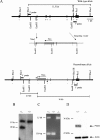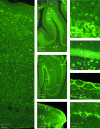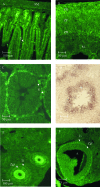The normal phenotype of Pmm1-deficient mice suggests that Pmm1 is not essential for normal mouse development
- PMID: 16847318
- PMCID: PMC1592770
- DOI: 10.1128/MCB.02357-05
The normal phenotype of Pmm1-deficient mice suggests that Pmm1 is not essential for normal mouse development
Abstract
Phosphomannomutases (PMMs) are crucial for the glycosylation of glycoproteins. In humans, two highly conserved PMMs exist: PMM1 and PMM2. In vitro both enzymes are able to convert mannose-6-phosphate (mannose-6-P) into mannose-1-P, the key starting compound for glycan biosynthesis. However, only mutations causing a deficiency in PMM2 cause hypoglycosylation, leading to the most frequent type of the congenital disorders of glycosylation (CDG): CDG-Ia. PMM1 is as yet not associated with any disease, and its physiological role has remained unclear. We generated a mouse deficient in Pmm1 activity and documented the expression pattern of murine Pmm1 to unravel its biological role. The expression pattern suggested an involvement of Pmm1 in (neural) development and endocrine regulation. Surprisingly, Pmm1 knockout mice were viable, developed normally, and did not reveal any obvious phenotypic alteration up to adulthood. The macroscopic and microscopic anatomy of all major organs, as well as animal behavior, appeared to be normal. Likewise, lectin histochemistry did not demonstrate an altered glycosylation pattern in tissues. It is especially striking that Pmm1, despite an almost complete overlap of its expression with Pmm2, e.g., in the developing brain, is apparently unable to compensate for deficient Pmm2 activity in CDG-Ia patients. Together, these data point to a (developmental) function independent of mannose-1-P synthesis, whereby the normal knockout phenotype, despite the stringent conservation in phylogeny, could be explained by a critical function under as-yet-unidentified challenge conditions.
Figures









References
-
- Aebi, M., and T. Hennet. 2001. Congenital disorders of glycosylation: genetic model systems lead the way. Trends Cell Biol. 11:136-141. - PubMed
-
- Akaboshi, S., K. Ohno, and K. Takeshita. 1995. Neuroradiological findings in the carbohydrate-deficient glycoprotein syndrome. Neuroradiology 37:491-495. - PubMed
-
- Antoun, H., N. Villeneuve, A. Gelot, S. Panisset, and C. Adamsbaum. 1999. Cerebellar atrophy: an important feature of carbohydrate deficient glycoprotein syndrome type 1. Pediatr. Radiol. 29:194-198. - PubMed
-
- Artuch, R., I. Ferrer, J. Pineda, J. Moreno, C. Busquets, P. Briones, and M. A. Vilaseca. 2003. Western blotting with diaminobenzidine detection for the diagnosis of congenital disorders of glycosylation. J. Neurosci. Methods 125:167-171. - PubMed
-
- Barone, R., L. Pavone, A. Fiumara, R. Bianchini, and J. Jaeken. 1999. Developmental patterns and neuropsychological assessment in patients with carbohydrate-deficient glycoconjugate syndrome type IA (phosphomannomutase deficiency). Brain Dev. 21:260-263. - PubMed
Publication types
MeSH terms
Substances
LinkOut - more resources
Full Text Sources
Molecular Biology Databases
